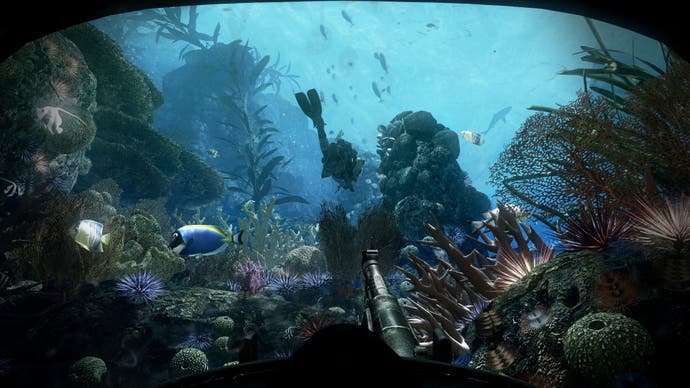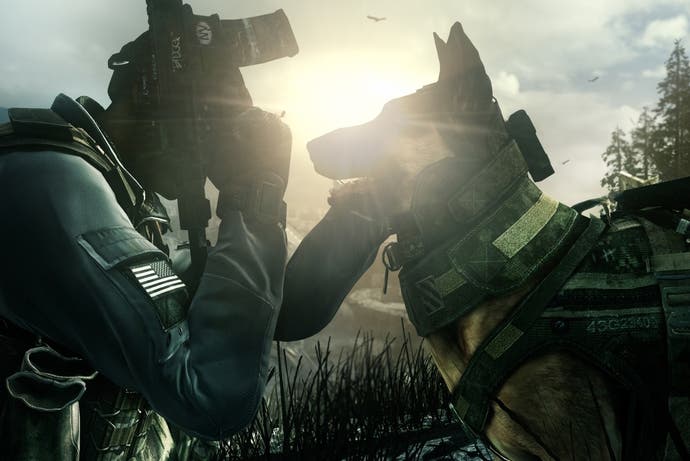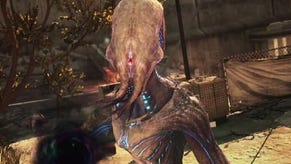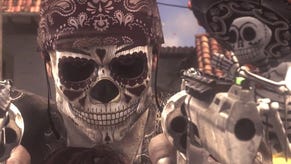Call of Duty: Ghosts review
Haunting season.
Do you remember that bit in The Dark Knight Rises when Bane escapes from a plane in flight, blowing it in half and whisking himself to freedom as the fuselage falls away? Infinity Ward certainly does. It recreates the scene almost exactly in Call of Duty: Ghosts. It's just one of many widescreen blockbuster moments in a game that is, as always, propelled more by macho bombast than narrative coherence - but in lifting so blatantly from such a famous scene in a recent popular movie, it offers us a glimpse at the desperate emptiness that can so easily creep into a series when annual updates require a constant stream of wow moments.
Following Treyarch's mostly successful attempt to inject change and ambition into the COD formula with Black Ops 2's branching narrative and loadout-agnostic construction, the Ghosts campaign can't help but feel like a step backwards. Penned by Hollywood screenwriter Stephen Gaghan - whose work includes such intelligent political thrillers as Traffic and Syriana - the dimwitted, flag-waving, chest-beating story is perhaps the biggest letdown.
In the opening scenes, we see how a US military satellite armed with kinetic rods - essentially giant space spears that use gravity alone to create horrifying devastation when they crash to Earth - is captured and turned against San Diego by the forces of the Federation. In one of the game's only surprises, this Federation is composed not of scheming Russians, imperial Chinese or demented Arabs, but of vengeful South American countries which turn a global energy crisis into the touchpaper for their own worldwide revolution.
There are many things wrong with the scenario, not least of which is that it's yet another shooter that paints the US as a victimised underdog, caught unawares by evil Third World forces, rather than an 800lb gorilla with a nuclear payload. Unlike Black Ops 2, which at least used its drone warfare storyline to question the wisdom of such weaponry in its own comic-book fashion, Ghosts never once suggests that giant city-crushing space spears are a bad idea - at least until those dastardly Hispanic hordes get their hands on them.

"The opportunity was there to flip the Call of Duty script... instead, it's another gasoline-fuelled romp through levels that feel like the last 30 minutes of a Roger Moore-era Bond movie on repeat"
The campaign fumbles its narrative in more deep-rooted ways as well. Despite a set-up in which America is on the back foot - the West Coast reduced to a post-apocalyptic state, the national infrastructure decimated and your characters allegedly members of a Spartan-esque cadre of elite soldiers even deadlier than the deadliest Spec Ops force - that's never really reflected in the scenarios you face. There's no sense that this is a guerrilla war, that you're relying on more desperate methods of fighting back against a superior force.
You still go into battle loaded with enough hi-tech gadgets to make Batman green with envy and, a few scripted upsets aside, you're almost always on the attack and armed to the teeth. In a story which has a rogue Ghost supposedly hunting his former comrades, the opportunity was there to flip the Call of Duty script, put the players in a defensive posture, on the run, under-resourced, relying on their wits rather than their arsenal, but instead it's another gasoline-fuelled romp through levels that feel like the last 30 minutes of a Roger Moore-era Bond movie on repeat. In a game which so obviously nods to Moonraker, that can't be an accident.
That's not entirely a criticism; there's no denying that when COD's cheeseball formula clicks, it's still capable of being devilishly entertaining, the closest gaming comes to the guilty pleasure of a 1980s action movie. Infinity Ward is still one of the best studios for knowing how to use the first-person perspective to put the player in outrageous situations, so whether you're leaping off a waterfall, scuba diving through a sunken, collapsing lighthouse or engaging in zero-G shoot-outs in orbit, the moment-to-moment thrills are still there, if muted by expectation. Once going over the top becomes the norm, it's hard to sustain that level of insanity and still surprise.
There are the expected slow-motion breaches and scenes where you man a turret, or shoot at pursuing cars during chases, but Ghosts does at least dip a tentative toe in vehicle combat waters. There's a helicopter section in which you actually control the helicopter - though it automatically adjusts its height so you don't crash as you strafe around. There's also a tank battle in which you're free to roar around an airfield, blasting away at rivals. It's all carefully contained, of course, and nothing that will give Battlefield developer DICE sleepless nights, but it's one of the few times when it seems Infinity Ward is aware of how threadbare its traditional corridors are becoming.
"Call of Duty has always owed more to classic arcade gun games like Operation Wolf than most of its FPS peers"

The campaign's only other real innovation - a playable dog - makes for a cute trailer but adds little in gameplay terms. Riley belongs to the story's nominal leads, literal brothers and brothers-in-arms Logan and Hesh, and can be unleashed on enemies, after which he bounds around the battlefield chomping on bad guys at random. Alternatively, you can control him directly, thanks to a camera on his harness, but only during a handful of canine stealth sections. These only occur a few times, and there's not much to them - you shuffle through long grass, following a clearly delineated course, and pull off silent kills much as you would with a knife in your hand.
Even more absurdly, Riley's silent kills are nothing of the sort, with enemies falling to the ground with screams of horror as the pooch rips their throats out. Nearby enemies with their backs turned somehow miss this, which is true of the puppet-like AI throughout. Call of Duty has always owed more to classic arcade gun games like Operation Wolf than most of its FPS peers, but even so the willingness with which enemies offer themselves up for a headshot manages to be both viscerally satisfying and tactically disappointing at the same time.
While the campaign is unlikely to lure you back once you've bullied your way through on Veteran, as usual it's the multiplayer where the long-term appeal lies. It's also where Infinity Ward's passion for the franchise can still be most keenly felt, with 15 maps (if you include the FreeFall pre-order bonus) and 11 game modes to play on them. The map design is typically slick, once again showcasing the developer's knack for crafting feedback loops in tangible digital form: tightly controlled arenas where every corner leads to two or three different traversal options. Over, under, around and through, this is perpetual motion as software design, with a graceful slipperiness that keeps matches in a constant state of restless, nerve-wracking movement.
While all the maps are predictably solid, few jump out as worthy of standing alongside COD classics. Urban maps such as Stormfront, Tremor and Octane are distinguishable more from their cosmetic flourishes - lightning strikes, aftershocks - than any unique elements in their construction. Most draw from the campaign. Maps such as Warhawk, set in a ruined small town with a high school football theme, tip the scales hard in the direction of inspirations such as the 1980s communist menace action movie, Red Dawn.
"Over, under, around and through - COD multiplayer is perpetual motion as software design"

The best maps are the ones that deviate from the limited environments of the story mode. Stonehaven is by far the most picturesque, taking place around a crumbling Scottish castle with open countryside pockmarked with gullies and hillocks. Whiteout sprawls across an Alaskan fishing village, balancing streets and building interiors with natural rock tunnels and treeline cover. Both feel fresh when compared to the grungy military installations and demolished Americana on display elsewhere.
In terms of modes, most of the new additions are variations on proven themes. Search and Rescue is the same as the bomb-planting Search and Destroy, except now downed players can be revived. Grind is essentially Kill Confirmed, except enemy dog tags must now be banked at specific points on the map to be counted. Hunted riffs on Gun Game, but with random weapon drops. The most entertaining new mode is the Statham-inspired Cranked, in which the standard Team Deathmatch set up is spiced up by a 30-second countdown that triggers as soon as you get a kill. From that moment on, you're "cranked" and gain more points and perks, but will also explode if you fail to get another kill before the timer runs out. It's utterly silly, but that's part of the charm.
Other changes to the multiplayer routine are minor in nature. A neat but inessential Clan Wars feature uses the new COD Elite app to track your clan's performance against similar teams from around the world, offering cosmetic unlocks and XP boosts for those that can dominate across the various multiplayer modes. Killing high-scoring opponents during matches, meanwhile, will spawn a briefcase containing Field Orders - get two kills while crouched, get a kill using explosives and so on - and completing these can activate special care packages and map-altering strikes.
This "dynamic maps" feature is interesting in theory, but the wow factor wears off pretty quickly in practice. Even the most dramatic of them - such as the devastating orbital attack that completely remakes the Strike Zone map - are heavily scripted, swapping one layout for another, so once you've been dazzled by the destruction, you'll soon get used to the result.
It's also a feature that brings Call of Duty into direct competition with Battlefield's Frostbite-powered demolition, and the comparison - while not an exact parallel - isn't flattering. Battlefield 4's "levolution" moments vary in their gameplay impact, but at least they feel of a piece with the game's wider commitment to an ever-changing landscape. Call of Duty simply lacks the deeper systems needed for such flexibility to truly work, and in such carefully stage-managed arenas it ends up more as neatly canned, predictable chaos - an oxymoronic variation on the Mini Nuke and MOAB strikes from Modern Warfares 2 and 3.

Elsewhere in multiplayer, the existing genre boundaries are faithfully acknowledged and adhered to. The new alien-blasting Extinction co-op mode is entertaining enough - how could it not be? - but adds nothing that a dozen other horde modes haven't already done. The Squads system is similarly traditional - dangling a carrot of asynchronous multiplayer that is quite enticing, but ultimately ending up as another way to play against bots. Both modes are nicely presented, and skirt around some interesting concepts, but in a game where 99 per cent of the players will be glued to Team Deathmatch it feels like a half-hearted attempt at diversification, offering solid takes on old multiplayer standards rather than anything that might surprise.
But then surprise has long been off the Call of Duty menu, and that's OK. The worst crime that Ghosts commits isn't that it doesn't completely reinvent the brand or genre - nobody expects that - but that it fails to illustrate a compelling next-generation vision for the series, retreating from ideas introduced in Black Ops 2 but introducing nothing substantial in their place.
To be fair, Battlefield 4 is similarly reliant on its own proven formula, but at least the advance of technology works in DICE's favour, allowing more players, more immersive maps, better vehicle physics. As consoles grow in power, Battlefield is well placed to grow with them. On the evidence of Ghosts, the next generation of Call of Duty sequels will look shinier but not much else, and that's a worrying sign of stagnation for a series with so much to lose.
Ghosts, in and of itself, is a fine game. It ticks all the boxes and then blows the boxes up in glorious 1080p resolution (on PS4 at least). Those who only ever play COD will be more than happy with it, but those who have grown weary of the series will see more of their ambivalence justified this time around. Infinity Ward had a chance here to throw down the gauntlet for the next hardware generation, to set the new standard, to show that this hugely popular, much derided behemoth can dance to a different tune. It's chosen to play a Greatest Hits package instead.

















